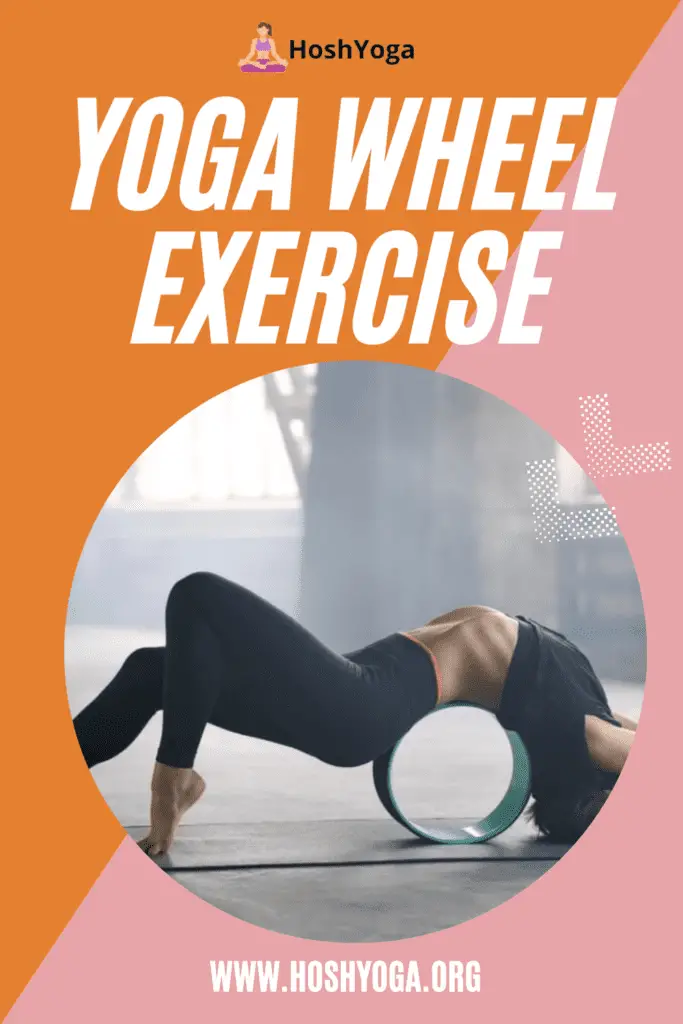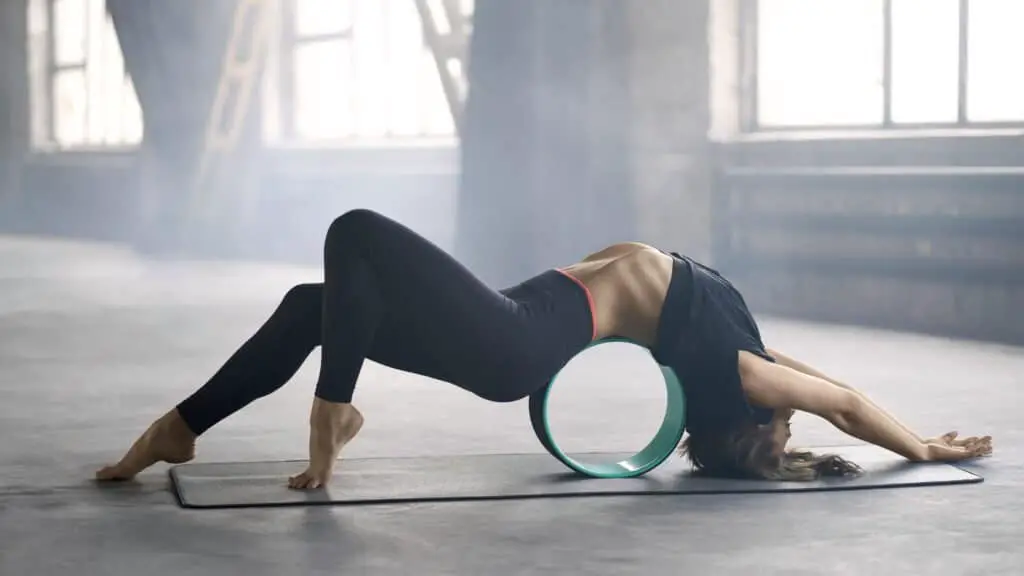Do you struggle with certain Yoga poses? Are you new to Yoga and in need of some support? If you answer “yes” to any of these questions, then a Yoga Wheel may be just what you need.
Yoga wheels are a relatively recent addition to many Yogi’s practices. These wheels are made from wood, cork, or rubber and allow the practitioner the chance to improve their flexibility.
If you want to learn more about yoga wheel exercises and their benefits, make sure to keep reading.
In the following section, we will discuss 24 yoga poses that you can modify with a Yoga Wheel. By adding the wheel to these poses, you can make them easier to perform while also developing the skills and body mechanics necessary to complete these poses without one in the future.
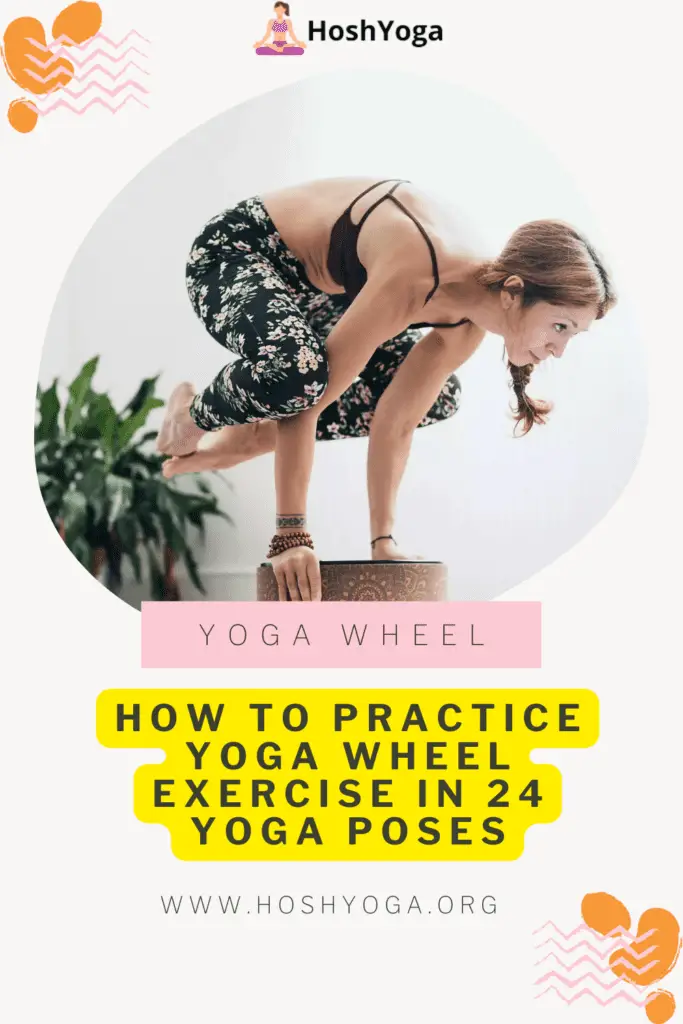
4 Yoga Wheel Poses for Strength Yoga Wheel Exercise
Lunge Pose
The lunge is one of the most fundamental poses in Yoga. This pose is a great way for beginners to develop the muscles in their thighs, core, and calves. You can also easily add a Yoga Wheel to this pose. To do so, perform the following steps:
- Start by standing in the Mountain Pose.
- Rest the bottom of your left shin on the wheel.
- Slowly lower yourself down and backward by bending your front leg.
- End in a lunge position, with your right thigh parallel to the floor.
- Do this at least five times before switching sides.

Rolling Plank
The Plank is one of the most fundamental exercises you can do. It is vital for all forms of Yoga since it strengthens the muscles in your core. If you can already perform a plank, then the Rolling Plank is the next step you should take. By adding a wheel, you can increase the difficulty to improve your balance and strength. To do this pose, you need to:
- Start on all fours, holding your wheel in front of you.
- Lift yourself up by straightening your legs and arms while engaging your core.
- Breathe in and out slowly. Aim to hold this position for between fifteen seconds and a minute.
Knee Tucks
While knee tucks are a fantastic way to develop your core strength, they can be challenging for beginners to perform. However, by adding a Yoga wheel, you can bridge the gap, developing your core and technique at the same time. To perform Knee Tucks with a wheel, you need to:
- Begin in a plank position. Place the wheel beneath the tops of your feet.
- Roll the wheel forward as you bring your knees into your chest.
- Return to the plank pose and repeat five more times.

Rolling Bridge
The Bridge is another excellent pose for developing the muscles in your core, particularly your obliques. By adding a Yoga wheel, you can make this pose slightly easier to perform while still gaining massive benefits. The Rolling Bridge Pose involves:
- Lay down on your back. Place the wheel beneath your feet, and keep your arms flat on the mat.
- Bend your knees, engage your abdominals, and roll the wheel towards you.
- Extend your legs and roll the wheel forward.
- Repeat between 5 and 10 more times.

4 Yoga Wheel Poses for Balance
Garland Pose (Malasana)
The Garland Pose, also known as Malasana, is deceptively challenging, especially when performed on a wheel. This pose requires excellent balance and focus. To execute this pose, you will need to:
- Start by squatting as low as you can while balancing on your wheel. Start next to a wall if you need to.
- Push your thighs out to the side and lean your torso forward.
- Bring your hands together as you push your elbows into your knees.
- Hold this position for as long as you can.

Toe Stand
The Toe Stand pose is another pose that will really push your balance to its limits. If you are new to Yoga, practice this pose close to a wall and on a soft surface, as you will fall many times attempting this pose. The Toe Stand involves the following steps:
- Stand on your wheel with your right leg. Stay next to a wall if you need to.
- Bring your left foot to your thigh as you bend your right knee. Squat towards the floor.
- In this position, rise up onto the ball of your foot.
- Press your hands into the mat to maintain your balance.
- Hold for at least five breaths.

Mountain Pose
This pose is another fundamental pose that all yogis should try to master. If you want to demonstrate your mastery of the Mountain Pose, performing it on a wheel is a great way to do so. Doing this pose on a wheel is a fantastic way to further improve your balance. The Mountain Pose involves these steps:
- Stand on top of your wheel. Keep your center of gravity between your legs.
- Spread your toes and activate your core muscles to retain your balance.
- Breathe in and out deeply ten times.
Low Lunge
The Low lunge, also known as the Crescent Moon Pose, is excellent for balance. However, this is not the pose’s only benefit. If you want to develop a strong core and legs, this pose is something you should try. To do this pose, you must:
- Step forwards with your left leg, keeping your left knee above your foot.
- Lower your right knee to the mat. Once this knee has touched the mat, press your right foot into the floor.
- Lift up your chest while keeping your back straight and above your pelvis. As you do so, raise your hands above your head and hold them together.
- Hold this position for at least five deep breaths.

6 Yoga Wheel Poses for Support
Half Moon Pose
The Half Moon Pose, while a great way to improve tough-to-reach muscles in the side of your body, is a pose many yogis find challenging. However, by adding a wheel, you can extend your reach, making this pose easier to do. If you want to practice this pose with support, start with these steps:
- Begin in the Triangle Pose.
- Move your weight forward, placing most of it over your right leg.
- Press your right hand into your yoga wheel.
- Straighten your right leg while simultaneously lifting your left leg from the floor. Keep your left hip on top of your right.
- Point your left arm up and activate your core.
- Your left leg should be parallel to the floor at this point. Hold this position for between 15 and 30 seconds.
Supported Headstand
The Headstand is one of the most impressive poses when performed well. By adding a wheel to your practice, you get the support and confidence you need to try this pose. If you can perform a Supported Headstand, you can develop the muscles in your core and shoulders you will need for a traditional Headstand. To do this pose, you need to:
- Start in a kneeling plank. Keep your forearms on the floor as you grip your wheel.
- Rollover slightly and press the top of your head into your forearms. Allow the wheel to support your weight.
- Move into the Downward Dog pose as you begin to raise your legs upwards.
- Keep your legs straight as you raise them over your head. Hold this position for 30 seconds at most. Make sure your shoulders and forearms carry your weight, not your head.

Supported Full Pigeon (Kapotasana)
The Supported Full Pigeon pose is one of the best for stretching the muscles in your lower back, core, and arms. If you are sedentary while working, this pose can be a great way to improve your posture. This pose involves the following steps:
- Start with your feet and knees on the mat.
- Make sure your wheel is behind your back.
- Roll your body back, lifting your hips and arms over the wheel.
- Stay in this position for ten deep breaths.
Supported High Lunge
The High Lunge is another variation of the lunge that is particularly good for your leg and core muscles. By using a wheel, you can give your body a rest between more challenging sets. This pose is also an excellent way to bring your practice to a close. To do the Supported High Lunge, you need to:
- Extend your stance by moving your right foot forward. Finish with your legs being one mat length apart.
- Keep your wheel below your left knee.
- Lower your right knee and raise your hands above your head.
- Stay in this position for between five breaths before switching sides.

Supported Boat Pose
Navasana, more commonly known as the Boat Pose, is one of the most challenging poses for new yogis to master. Adding a wheel gives you the chance to slowly work on your technique and balance, both of which are necessary for this pose. To perform the Supported Boat Pose, you must:
- Sit and bend your knees. Press your big toes into your wheel.
- Roll backward and rest on your backside.
- Raise your feet upwards. Try to get them to at least knee height.
- Straighten your legs and hold this position for at least five deep breaths.

Supported Crow Pose
If you want a pose that will build strength, balance, and discipline all at once, then the Supported Crow Pose is what you need. Your arms and wrists will get an excellent workout from this pose. By adding a wheel, you can focus on developing your strength without worrying about falling. The Supported Crow involves the following steps:
- Begin in a deep squat. Press the balls of your feet into the wheel. Keep your hands on the ground if you need to.
- Keep your hands beneath your shoulders and press your palms into the mat.
- Fold your body forward and press your knees into your armpits. Make sure to keep your wheel beneath your feet in this position.
- Hold this position for at least 15 seconds.
:max_bytes(150000):strip_icc():format(webp)/photo011-5a459eaaeb4d520037c2059f.jpg)
7 Yoga Wheel Poses for Flexibility
Child’s Pose
The Child’s Pose is one of the best ways to relax at the end of a class. By using a yoga wheel, you can actually get a good stretch as well. To perform the Child’s Pose, you need to:
- Start in a kneeling position and rest your thighs on your calves.
- Grab onto your wheel and push your arms forward. Stretch your upper body forward.
- End with your forehead on the mat and hold this position for between 15 and 30 seconds.
:max_bytes(150000):strip_icc():format(webp)/photo014-5a459ea24e46ba00367e888e.jpg)
Head to Knee Forward Bend
The Head to Knee Forward Bend can be a difficult pose for many. This is why adding a yoga wheel is so beneficial – it gives new yogis the chance to practice what might otherwise be an impossible pose. To practice this pose with a wheel, you need to:
- Begin in the Staff Pose.
- Bring your right foot to your thigh as you bend the opposite leg.
- Bend your pelvis and start to lean forward. Point your foot towards the ceiling.
- Hold on to your wheel and roll it forward to get a deeper stretch.
- Hold this position for a few breaths before switching sides.
Seated Forward Bend
The Seated Forward Bend is a fantastic way to improve your general flexibility. It is also especially good for stretching your legs and lower back. To perform the Seated Forward Bend with a yoga wheel, you need to do the following:
- Begin in the Staff Pose with your wheel at your feet.
- Grab onto your wheel and bend forward at your hips.
- Keep your spine and neck in a single line as you lean forward.
- Keep your feet flexed and hold this position for at least 5 deep breaths.
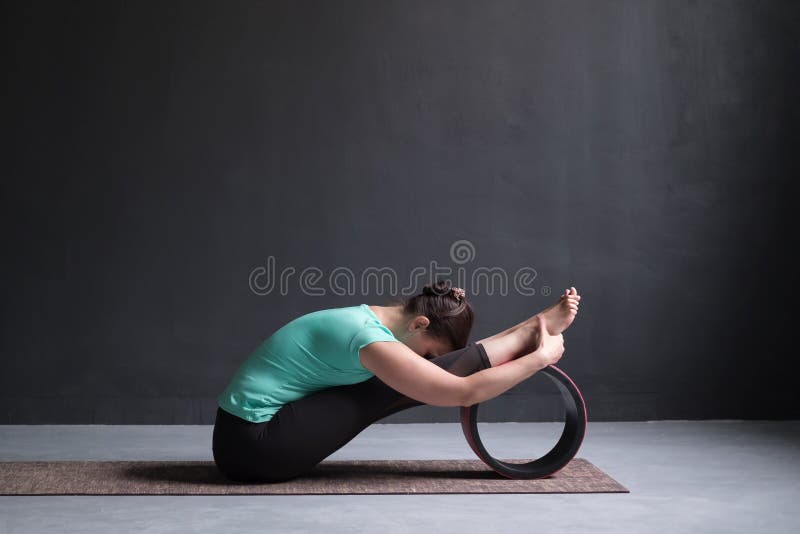
Lizard Pose
If you have tight hips, performing the Lizard Pose with a yoga wheel is a fantastic way to deal with this issue. The Lizard pose is also a great way to develop your core strength. To do this pose, you need to:
- Begin in the Downward Dog pose. Hold your wheel in your hands.
- Move into a deep lunge position by moving your left leg forward, next to your left hand.
- Press your forearms and right leg into the ground. Stand up on the ball of your foot.
- Stay in this position for at least 5 breaths.

Splits Prep
The Splits is one of the most impressive poses in all of Yoga. However, many yogis need to prepare their bodies to perform this pose. One of the best poses for this is the Seated Wide-Legged Forward Fold or the Upavistha Konasana. To perform this pose, you need to do the following:
- Sit down and stretch your legs out in a “V” shape. Push them out as far as you can.
- Lean forward on your yoga wheel. Doing so will start to open up your inner thighs.
- If you can, slowly move your wheel forward to extend this stretch.
- Hold this position for at least 10 breaths.
Gate Pose
If you want to develop flexibility in your hips, you should practice the Gate Pose frequently. By adding a yoga wheel, you can give yourself a much deeper stretch. There are a few steps in this pose:
- Start kneeling with your wheel on your right.
- Push your right leg out to the right and place it on the wheel.
- Once you have extended your leg, straighten your torso and raise your left hand upwards.
Standing Forward Bend
The Standing Forward Bend is an excellent way to stretch your hips and legs, especially your hamstrings. You can extend your reach by using a yoga wheel, making this useful pose more accessible. To perform the Standing Forward Bend, you need to:
- Start in the Mountain Pose and bend forward at the hips.
- Activate your leg and abdominal muscles.
- Grab onto your yoga wheel and hold this position for a few deep breaths.

3 Yoga Wheel Poses for Releasing Tension / Reducing Pain
Butterfly Pose
The Butterfly Pose is a fantastic way to alleviate tension in your lower body, especially around your hip flexors and thighs. This pose is simple to perform, making it a great addition to your morning routine. To do the Butterfly Pose with a wheel, practice the following:
- Start in a seated position. Place your wheel in front of you and put both of your feet through it.
- Keep your spine straight above your pelvis.
- Push your feet against the wheel and press your elbows against your thighs.
- Slowly lower your torso and push down on your thighs. Hold this position for 30 seconds.
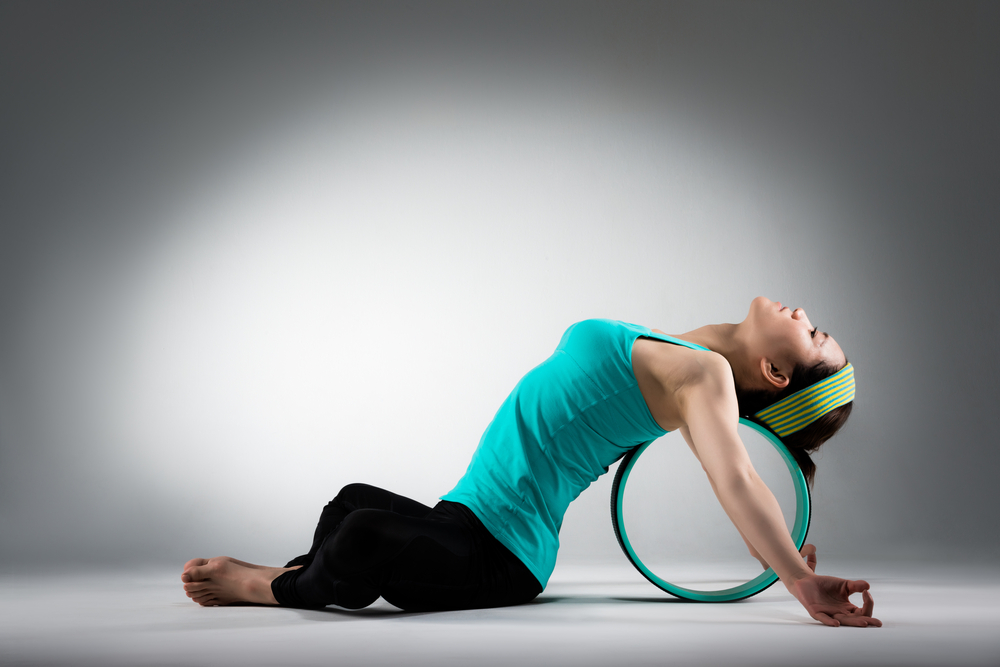
Spine Massage
There are quite a few yoga poses that will help open up your spine. One of the most commonly practiced is the Supine Spinal Twist or Supta Matsyendra Sana. With a wheel, you can avoid stressing your core, allowing you to focus on opening up your lower back. To do this, follow these steps:
- Lay down on your back with your knees bent. Rest your calves on the wheel.
- Activate your core before twisting both knees to one side.
- Rest your legs on the wheel before repeating this motion on the opposite side.
- Repeat at least 10 times.

Fish Pose
Matsyasana, or the Fish Pose, is another excellent pose for those who struggle with lower back issues. This pose will open up your hip flexors while also giving your shoulders a solid stretch. The Fish Pose involves the following steps:
- Sit down with your wheel behind your straightened back.
- Breathe in and roll back onto your wheel. As you do so, place your hands beneath your bottom. Keep your elbows and forearms below your body.
- Lift your head and torso upwards as you roll back a little bit more, opening up your chest and shoulders. Keep your feet and lower body on the floor.
- Stay in this position for as long as is comfortable.
With all the best poses in mind, you may still have questions about your Yoga Wheel. In this section, we will answer some of the most frequently asked questions about yoga wheels.
:max_bytes(150000):strip_icc():format(webp)/photo003-5a4597da842b170037abf0b0.jpg)
What Size are Yoga Wheels?
Yoga wheels usually come in one of three sizes. Small wheels are ideal for smaller yogis (less than 5ft tall). These wheels are about 6.5 inches in diameter. They are also a good investment for yogis that want to stretch more hard-to-reach muscles.
Standard-sized wheels are best for general use. Standard wheels are about 12 inches in diameter and are ideal for most yogis that just want to try using wheels.
Finally, large yoga wheels are designed for taller and bigger yogis. These wheels are usually about 15 inches in diameter and can bear much heavier weights. If you want to stand on your wheel for balance, these wheels are your best choice.
How Much Weight Can a Yoga Wheel Hold?
The amount of weight a yoga wheel can bear really depends on the material the wheel is made from. Certain wheels, especially larger ones, can hold more weight while smaller ones cannot. The average yoga wheel on the market today can hold between 400 and 500 pounds (between 181 and 226 kilograms). However, the strongest wheels on the market can carry up to 1000 pounds without issue, making them an excellent choice for Yogis that want to be sure of their wheel’s reliability.
How Much Do Yoga Wheels Cost?
Yoga wheels vary in price greatly. However, the cost for an average, good-quality yoga wheel will be between 25 and 50 dollars. However, more expensive and specialized options are available, which can cost over 200 dollars. These prices make wheels some of the more costly pieces of equipment a yogi can purchase.
How Do You Maintain a Yoga Wheel?
If you want to keep your yoga wheel for years, you have to keep them clean and store them safely. Cleaning a yoga wheel is relatively simple; the best way to do this is to wash your wheel by hand. Get a spray bottle with water or a damp cloth and wash your wheel after every use to keep it clean.
Conclusion
A yoga wheel can be an excellent addition to your practice. If you struggle with flexibility, are recovering from an injury, or are just starting yoga, a wheel can be a great way to practice poses you may otherwise find too challenging to do.
Wheels are flexible tools that have many uses, including strength development, and injury recovery, as well as being a way to test your skills.
If you have any questions about Yoga wheels, yoga wheel exercises, or have experience using them, please let us know in the comments.
